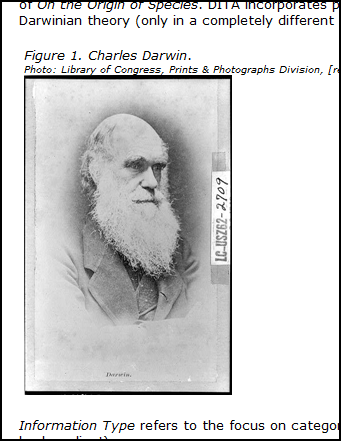Figures and images
Images are placed in topic content using the image element. The image element can stand alone, or can be contained within a figure (fig) element.
Although images can be placed in a DITA topic as image elements without a surrounding figure element, figures are generally the best way to structure graphics and other illustrations. The exception is for simple inline images (that is, images that are part of the flow of the text), where an independent image element should be used.
Most commonly, images are stored is separate files external to DITA, but it is possible to embed XML-based image formats, such as SVG, within the DITA topic XML.
Figures in DITA are container elements typically comprising a title element, an image element, and a desc element.
<fig>
<title>Charles Darwin</title>
<desc>
<cite>Photo: Library of Congress, Prints & Photographs
Division, [reproduction number, LC-USZ61-104]</cite>
</desc>
<image placement="inline" align="right" width="208px" height="320px"
href="../images/darwin_library_of_congress.jpg">
<alt>Photo of Charles Darwin: Library of Congress, Prints and
Photographs Division, [reproduction number, LC-USZ61-104]</alt>
<image>
</fig>The title element contains a short, descriptive title of the figure. The image element's attributes contains the location, dimensions and placement of the image file, and a child alt element containing an alternative text description of the image (for reading devices that don't display images or readers who don't see images). The desc element contains further information about the image, including any photo credits or citations.
Although the title element appears before the img element in DITA mark-up, the sequence can be altered in the output by modifying the publishing process. Do not break the semantics by using workarounds (such as moving the title to figgroup element after the img) to achieve a formatting outcome.
